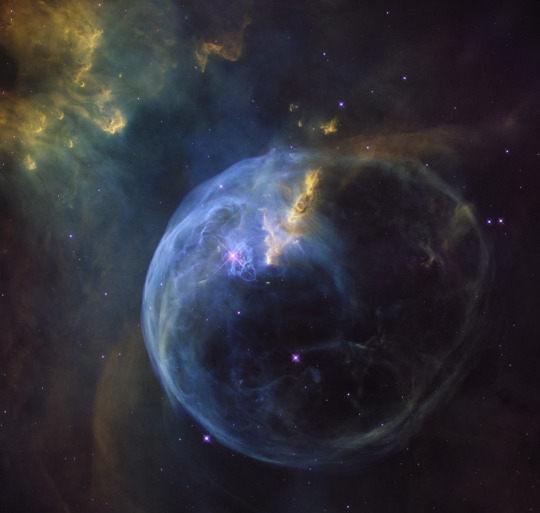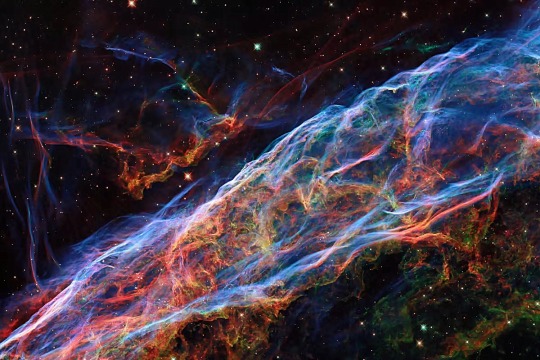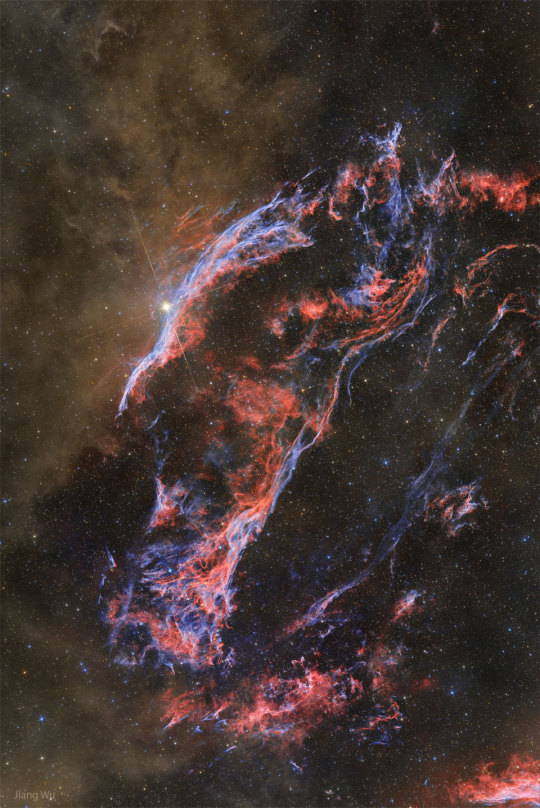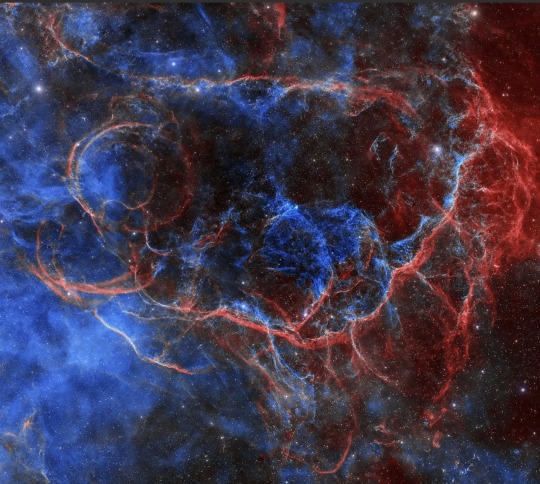#veil nebula
Explore tagged Tumblr posts
Text

Along the Western Veil ©
#astrophotography#space#veil nebula#supernova remnant#nasa#apod#galaxy#universe#solar system#planet#stars#astronomy#cosmos#night sky
1K notes
·
View notes
Text


810 notes
·
View notes
Text

The Veil nebula is the remains of a massive star that exploded as a supernova roughly 10,000 years ago. (NASA/Hubble image)
#nature#astronomy#photography#science#aesthetic#space#physics#stars#sky#outer space#NASA#Hubble#nebula#astrophotography#nature photography#cosmos#night#night sky#beauty-funny-trippy#veil nebula
477 notes
·
View notes
Text

The Western Veil Nebula, NGC 6960 // Karl-Heinz Macek
The bright star is 52 Cygni which is in the foreground and unrelated to the nebula.
#astronomy#astrophotography#nebula#emission nebula#diffuse nebula#supernova remnant#veil nebula#western veil nebula#NGC 6960#star#giant star#52 cygni#cygnus
593 notes
·
View notes
Text

The Dolphin-Head nebula (Sh2-308)
#veil nebula#planetary nebula#nebula#dolphin#astronomy#astronomers#universe#nasa#nasa photos#astrophotography#outer space#astrophysics#nasawebb#hubble space telescope#space exploration#space#science#space travel#international space station#space program#astronomy facts#nasa science#science facts#planetary science#space science#alien planet#planet earth#solar system#our universe#the universe
193 notes
·
View notes
Text

Western Veil Nebula l NASA APOD
#space#astrophotography#astronomy#nasa#apod#universe#veil nebula#stars#night#galaxy#solar system#planets#sky
719 notes
·
View notes
Text

Eastern Veil Nebula in Cygnus
#art#cosmos#cosmic#universe#blast#space#photography#wallpaper#veil nebula#nebula#cygnus#bat#astrophotography#NGC6992#sky#galaxy#deepspace#surreal
88 notes
·
View notes
Text
The Western Veil Nebula
The Veil Nebula is interstellar debris from a very large star that violently exploded as a supernova about 15,000 years ago. This photo captures the leading shockwave as it continues to expand.
Astronomers call this Supernova Remnant the “Cygnus Loop”, because it is generally circular and viewed in the constellation of Cygnus the Swan. It is nearby at only 2,400 light years, and situated right in our own galactic spiral arm, making our image very crowded with nearby stars.
In this photo, we are looking at the outer edge of the Cygnus Loop debris field that appears facing towards the west. Note the colours: red is hydrogen, blue suggests oxygen, and sulfur is green.
A “Supernova” explosion occurs when an older star depletes fuel and begins to falter at generating a strong stellar wind. As the outward-push falters, gravity causes the aging star to catastrophically implode as a supernova. Indeed, the colours of blue and green suggest the presence of heavier elements, oxygen and sulphur, as formed in the core of older stars.

I photographed the Western Veil Nebula from my garden in Strasbourg France on a single night in August 2024. This is an ensemble of 80 photos, where each was a 3 minute exposure (4 hours of Astrophotography).
More information:
#astrophotography#astronomy#astrophotographie#astrophotographiefrance#astronomie#astronomiefrance#nebulae#veil nebula#veilnebula#Cygnus loop#nebula#strasbourg#cygnus#supernova remnant#supernova
54 notes
·
View notes
Text

Rampaging Fronts of the Veil Nebula - March 7th, 1996.
"A supernova explosion of a high-mass star results in fast moving blast waves. At the front of the waves shown above, ionised gas in the Veil Supernova Remnant rushes out from the explosion, sweeps up material, and breaks up many atoms into constituent ions and electrons. Observations with the Hubble Space Telescope in 1993 indicate that the blue shock wave was catapulted away from the stellar explosion after the red shock wave, and had yet to catch up to it in some regions. The Veil supernova remnant's has a very large angular size - six times the diameter of the full Moon - and different parts of it are known as the "Cygnus Loop" and catalog numbers NGC 6960, NGC 6979, NGC 6992, and NGC 6995."
#nasa#space#cosmos#universe#astronomy#astrophysics#astrophotography#veil nebula#supernova remnant#cygnus loop
117 notes
·
View notes
Text

The Eastern Veil Nebula (OHS, starless)
The Veil Nebula is a 15,000 year old supernova remnant in the Cygnus constellation, which is loaded with heavily ionized gas due to the high energies emitted during its parent supernova and spread out in swirling tendrils from the force of the blast. The full Veil Complex is vast, but zooming in on the target reveals incredible levels of detail like this.
This shot is a tight zoom on the end of the Eastern Veil Nebula, shot at 1600mm with a 200mm Ritchey-Chretien telescope and an ASI533MM camera. 8h 30m of total integration time across Ha, Sii, and Oiii narrowband filters (7nm bandpass). Data gathered over two nights.
Edited with PixInsight.
#astrophotography#astronomy#space#deep sky#nebula#narrowband#night sky#lensblr#emission nebula#veil nebula#supernova#supernova remnant#photography
51 notes
·
View notes
Text






Late August 2024. 6 images from Cherry Springs State Park.
Equipment: Celestron C9.25 XLT scope, Optect TCF focuser, Optec Pyxis rotator, Optec F/6.3 focal reducer, QHY268M camera binned 2x2. Astrodon Series E LRGB filters.
Mount is a 23 year old Losmandy G11 with an Ovision worm on the RA axis and a Losmandy high precision worm on the DEC axis.
Effective FL: 1901 mm (f/8). Scale .82 arc-sec per pixel.
Exposures for most objects 20 x 180 seconds per color channel (RGB).
We had one night of clouds on Sunday, but it was clear enough to get polar aligned and test the mount. I shot some dark frames and biases during the time as well.
Had a pier crash during week. No damage. Reset safety positions. Discovered I can't reach zenith on motor side of mount. Ordered the RA extension. Also upgrading to Gemini 2 Level 6.
Overall, a great week. Been a year since last outing. 6 objects imaged in 4 nights! Must be a record for me!
No more trips this year. Will do some planets later this year and through winter.
31 notes
·
View notes
Text

What remains of a star that died as a Supernova! This is part of the Veil Nebula. Photo by Ilan Shapira.
45 notes
·
View notes
Text

This is the Crescent nebula it is located in the constellation Cygnus. This nebula is the result of the center star first becoming a red supergiant and ejecting some of its outer layers of gas in space, that gas cloud was then shaped into a bubble by the stellar winds emitted by the central star when it later turned into a Wolf–Rayet star.
The resulting gas bubble is heated and ionised by both the UV rays edited by the start and the stellar winds causing it to glow. Wolf-Rayet stars are the final step of some of the most massive stars before they explode into supernovas. In the case of the crescent nebula, the central star is expected to go supernova within the next few hundred thousand years (We probably still have quite a bit of time left before we observe that).

When a star goes supernova, some of the matter that composed the star is blasted off into space at extremely high velocities (up to 10% of the speed of light). This matter will then slowly (few hundred to a few tens of thousand of years) slow-down and cool-down to for me vast clouds of interstellar dust and gas. This second photo is a part of such a gas cloud, the veil nebula (the center of the western veil, also known as C34). In short, this is the photo of what's left of the corpse of a star that exploded about 10 to 20 thousand years ago.
#astronomy#astrophotography#space#night sky#nebula#veil nebula#crescent nebula#nearly finished processing the photos from two weeks ago#hopefully were gona have some clear night soon#photos taken from my backyard
34 notes
·
View notes
Text

A nebula inspired by a giant squid and the Veil Nebula.
My favorite cryptid growing up, but now considered a real species. How often does that happen?
#art#digital art#veil nebula#giant squid#stars#galaxy#colorful#space#sea monster#scifi#nebula#universe#orange#cosmos#blue#red#sea creature#squid#space art#scifi art#artists on tumblr
78 notes
·
View notes
Text

The Eastern Veil Nebula // Ryder Cobean
#astronomy#astrophotography#nebula#emission nebula#supernova remnant#veil nebula#eastern veil nebula#NGC 6992#NGC 6995#IC 1340#cygnus
97 notes
·
View notes
Text
Vela Supernova Remnant Nebula

#nebula and quasar#heart nebula#planetary nebula#nebulosa#nebula#veil nebula#supernova#astronomy#nasa#astronomers#universe#astrophotography#nasa photos#astrophysics#outer space#nasawebb#hubble space telescope#astronews#i love astronomy#astrography#astro notes#astro community#astro observations#astroblr#astrology observations#astro boy#space travel#space science#space exploration#space
479 notes
·
View notes